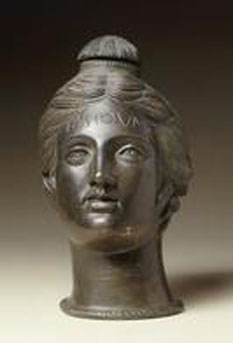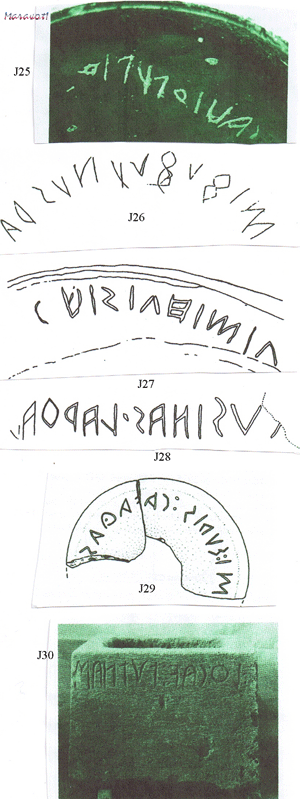Translation of short inscriptions.

Etruscan_Phrases
Translation of Short Inscriptions
(continued)
Scripts J25 thru J30, Devotional Plates & Vases
(Etr. LEXAIE)
Note: See updated document, Worknotes
on Etruscan Devotional Plates, Scripts J25-J40
by
Mel Copeland
(from a work published in 1981)
|
General note: The
scripts on this page are short texts found
on devotional wares, selected from texts
provided to Academia.edu. The texts are
quite short but many of the words
correspond with words in the Etruscan
Phrases GlossaryA.xls.
Similar devotional wares are at Script
BR, Script
OM, Script
AK, Script
PA. |
|||||||
| Images J25- J30 from Danial F. Maras, Un'inedita iscrizione falisca nel Museo di Cattolica, Rivista di antichita, Anno XVIII-n.2-Luglio-Dicembre 2009, Loffredo Editore Napoli - Provided to Academia.edu | Script J
J25-1 CALII J26-1 MI VOVO (8V8V) VN OSRA mine, my (L. meus-a-um; mihi, Dat. It. mi, myself) I vow promise to a god (L. voveo, vovere, votum; Ind. Pres. 1st Pers. singl. voveō; It. voto, vow; Fr. vouloir, to wish) one (L. unnus-a-um, unius, uni, una; It. un, uno, una; Fr. Un, une; Welsh, un-au) use, enjoyment; esp. use of borrowed capital; interest paid for money borrowed (L. usura-ae) J27-1 COIZIA HIMIA coming together, meetings; factions, coalitions (L. coitio -onis, 3rd Decl. Pl. Nom. -ia) winter/ storms (L. hiems [hiemps] -emis, f. winter, the cold or winter, stormy weather, storm, 3rd Decl. Pl. -ia) J28-1 CV SINAS LARTHA (LARΘA) to unite, assemble together (L. coeo-ire) a large bowel (L. sinus-i, m. and sinum-i) Lartha, name or bacon (L. lardum [laridum]-i) Note: A name, LARTHIA PHARNIES, appears on a stele, Script PM: (See http://www.maravot.com/Translation_ShortScripts_e.html) PM-1 MI LARTHIA (LARΘIA) PHARNIES (ΦARNIES) mine, my (L. meus-a-um; mihi, Dat. It. mi, myself) name, Larthia, Pharnies PM-4 VCHVLEIM VIRI REVS TIE the eye (L. oculus-i; 3rd Decl. Acc. -em) of men (L. vir, viri) defendant /accuser party in law-suit (L. reus-i and rea-ae) of the day (L. dies-ei, day; diu, by day; diutiuus, longer; Welsh, dydd; Scot, di). "I am Larthia Pharnies the eye of men, accuser / lawyer? of the day" J29-1 MI :SORIS (SVRIS) : CA FATHAS (FAΘAS) mine, my, me (L. meus-a-um; mihi, Dat. It. mi, myself) Soris, name, by which way, where, whereby, as far as (L. qua) you confess, make known, reveal (L. fateor, fateri, fassus; Ind. Conj. 2nd Pers. singl. fateās) Note: A votive bust in the Louvre (Script LF-1) contains the name SORIS or SORISA. (See http://www.maravot.com/Translation_Short_Scripts.html).This bust is similar to a bust of an Etruscan queen recorded in the Perugia Cippus whose name is RINA SARINA (K49). (See http://www.maravot.com/Translation_Perugia_Cippus.html)  J30-1 LOCAE TVTNAS the places (L. locus-i, 1st Decl. pl. -ae) Totnas, name.
|
||||||
 |
|||||||
|
J31
text from Etrusco
maunuxva cepen
[1]
J31-1 LAR RAL
(or
Thal)
(Divine
Mirror); she is the Etruscan Nemesis,
mother of Helen of Troy. RAL/THAL
appears
at: K60, TC86, TC283, TC314, GA-3;
J5-7.
Fel (the
great) heart, mind (L. cor, cordis)
of a device, artifice, deceit (L. dolus-i,
Gen. N. or Acc. Single –um) death the
foot (L. pes, pedis) he knows (L. nosco,
noscoere, novi, notum, Ind. Pres. 3rd
Pers. single noscit) not (L.
nae, ne) I spring, emanate, arise (L.
emano-are, Ind. Pes. 1st Pers.
Single emano) J33
Inscription TLE37,
“Note di Depigrafia Etrusca Veinte”[2] J33-4
CF LARI LECHAIE
I
assemble (L. coeo-ire, Ind. Pres. 1st
Pers. Single coeō) to, for the
god, household gods, lars, penates (L. lar,
laris, lares; 3rd Decl. Dat. -i)
the rule, precept, agreement (L. lex, legis,
Gen. Single –ae)
J34-1
FANI CE the
temple, holy place
(L. fanum-i, Gen. Single -i) wherewith,
wherefrom (L. qui, old abl. of qui;
qui, quae, quod, any, some; relat. Who,
which, what)
J35-1
ARNV NATVR
AN IRIAE SEKA SE to
the Arno, river & gens (L. Arnus-i,
2nd Decl. Dat. Single –o) of
nature, birth (L. natura-ae, Gen. Single)
or,
whether (L. an) to, for the anger (L.
ira-ae, 1st Decl. Dat. Single
–ae) he separates, cuts (L. seco, secare,
Ind. Pres. 3rd Pers.
Single secat; It. seccare; Fr. sécher) by
himself, itself (L. se, m. sese, f.; It. si;
Fr. se)
J37
Pontecagnano, Inscription T.3757, Fig. 4
J39
Inscription Pontecognano, Pellegrino,
T.2706 J39-1
ANK PETETO J40
Inscription on
sarcophagus, Museo Etrusco Gregoriano, CIE
5818
J40-9 LARO Notes: [1]
Pontecagnano: “L’uso della scrittura tra
Etruschi, Greci e Italici,” Carmin
Pelegrino, Bollettino Di Archeologia On
Line 2010 (Ignasi-Xavier
Adiego
Lajara posted this paper on
academia.edu, 6 November 1013). [2]
Pontecagnano:
“L’uso della scrittura tra Etruschi, Greci
e Italici,” Carmin Pelegrino,
Bollettino Di Archeologia On Line, 2010,
“Note di Epigrafia Etrusca Veinte.” [3]
Pontecagnano:
“L’uso della scrittura tra Etruschi, Greci
e Italici,” Carmin Pelegrino,
Bollettino Di Archeologia On Line, 2010 |
|||||||
—Θ
Launched 05.01.12
Upadated:
11.22.13
Copyright
© 1981-2014 Maravot. All rights reserved.
Copyright © 1981-2014 Mel Copeland. All rights
reserved.
